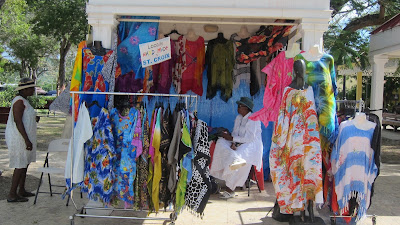Frederiksted is a picturesque waterfront town where cruise ships unload tourists.
Adventure of the Seas, a Royal Caribbean cruise ship.
Then the town comes alive with merchants selling their wares.
Frederiksted was established in 1751 and is the second largest town in St. Croix. In 1878, it was destroyed by arson in a labor revolt known as "The Fireburn", led by four female laborers. Frederiksted was rebuilt in a Victorian style after the fire.
Fort Frederik, the red and white landmark, was built in 1750 to protect the town from pirates. In 1776, the first cannon salute from foreign soil to the new nation of the United States of America is said to have been fired from the fort.
Clock Tower on Frederiksted Boardwalk
Freedom Statue
The area adjacent to the fort and waterfront has been made into a park. It contains statues of historically important Virgin Islanders. This park, Emancipation Park, honors the slave revolt leader, General Buddhoe, and honors the 1848 proclamation by Governor Peter von Scholten that freed slaves in the Danish islands. (He was recalled and died in disgrace as a result.) There are several benches beneath the Mahogany trees and a gazebo where entertainers preform when cruise ships come to port.
There are older buildings in town as well as ruins from the 1989 hurricane, Hugo.
Moko Jumbies have been in the Virgin Island’s cultural heritage for over 200 years and can be traced to Africa as far back as the 13th and 14th centuries. Men, women and children perch high up on stilts, dressed in bright colors and masks. In this costume they are no longer men, women, and children – they have now transformed into Moko Jumbies. The actual meaning of the words Moko Jumbies varies depending on whom you ask. In Central Africa, the word ‘moko’ means healer, while most English speaking people interpret moko as ‘mock’. ‘Jumbie’ would be slang for ghost, or spirit. West Africans view a Moko Jumbie as a seeker or a protector whose tallness is symbolic of the power of God. Many African tribes believed that Moko Jumbies acted as the spiritual seers and protectors of the village. It was believed that the height of the Moko Jumbies allowed them to see evil before it arrived and therefore they could warn other villagers. Traditional African Moko Jumbie costumes were adorned with mirrors in the belief that evil spirits were afraid to see themselves. In Central Africa, it is believed that the Moko Jumbie chases off evil spirits by its mockery of them.
Today, in the Virgin Islands, Moko Jumbies are simply entertainers who dance on stilts for tourists. They are devoid of any spiritual symbolism.
Below is the transformation of a man into a Moko Jumbie.
The chance to try some local food is always fun. We tried the beef and conch paté from Lavand's Spicy Treats wagon. It is basically a cooked mixture of your choice of meat or fish combined with peppers, onion, garlic, celery, parsley, hot pepper, and oregano, wrapped inside a large circle of dough, folded, and sealed. Then it is deep fried until golden brown. They were quite tasty!
Paté
























